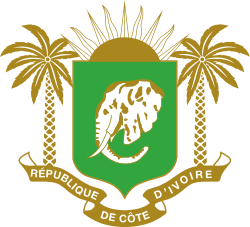French legislative election, 1945 (Ivory Coast)
 |
| This article is part of a series on the politics and government of Ivory Coast |
|
|
Government |
|
| Foreign relations |
Elections to the French National Assembly were held in the territory of Ivory Coast on 21 October 1945, with a second round on 4 November as part of the wider parliamentary elections. Voting was carried out using separate electoral colleges for citizens and non-citizens.[1] François Reste de Roca and Félix Houphouët-Boigny were elected.
Background
In September 1944 African planters formed the African Agricultural Union (SAA) as a result of government policy that allowed them to be drafted as forced labour and their plantations destroyed based on allegations of infections with plant disease (although the real reason was that they were competing too successfully for the liking of European plantation owners).[2] The union was led by Félix Houphouët-Boigny, and received support from the colony's administrators, resulting its members being exempted from forced labour. However, this went down badly with the European planters, who successfully lobbied the French government to remove Governor André-Jean-Gaston Latrille and replace him with Henry Jean Marie de Mauduit, who was more sympathetic to their views.[2]
Ivory Coast's capital Abidjan had been given the status of "commune mixte of the second degree" in 1939, introducing elections for a town council. However, they were delayed due to World War II, and were held for the first time on 26 August 1945.[3] Although not a political party, the SAA was the most prominent African organisation in the territory and an African Bloc was formed around it to contest the elections, putting forward an exclusively African candidate list.[3] Despite attempts by Europeans to get the elections postponed or boycotted, the Bloc went on to win the elections, as no Africans were willing to stand against them.[3]
Campaign
The Bloc sought to secure a similar outcome for the second college elections to the National Assembly, but could not agree on a candidate.[3] Intellectuals in Abidjan supported Kouamé Binzème, whilst SAA members backed Houphouët-Boigny. Binzème eventually contested the elections with the support of the Patriotic Action Committee of Ivory Coast.[4]
Houphouët-Boigny attempted to court the support of Mogho Naba Saba II, king of the Mossi. However, the Mossi were keen to regain separate status for Upper Volta, which the French had merged into Ivory Coast in 1932. As a result, they formed the Voltaic Union under encouragement from Governor Mauduit, and possibly under pressure from the Governor, the Mogho Naba put forward his "Baloum Naba" (chief of the pages), Tenga Ouedraogo, as a candidate. However, Houphouët-Boigny did gain the support of the Bobo, who disliked the Mossi.[5]
As a result, Houphouët-Boigny drew most of his support from Ivory Coast, whilst Tenga Ouedraogo's support was concentrated in Upper Volta.[6] Despite not being able to speak French, Tenga Ouedraogo's campaign received the full support of the colonial administration, who were seeking to prevent Houphouët-Boigny winning.[7] However, it was claimed that Tenga Ouedraogo advised voters not to vote for him due to his lack of French education.[8]
Results
Houphouët-Boigny won the second college vote largely due to the strong organisation of the SAA in the south of Ivory Coast and the support of the Bobo.[3]
| Candidate | Party | First round | Second round | |||
|---|---|---|---|---|---|---|
| Votes | % | Votes | % | |||
| First College | ||||||
| François Reste de Roca | Radical-Socialist Party | 785 | 27.2 | 1,821 | 65.6 | |
| Richard-Édmond-Maurice-Édouard Brunot | SFIO | 628 | 21.7 | 953 | 34.4 | |
| Peraldi | Independent | 428 | 14.8 | |||
| André Schock | Independent | 339 | 11.7 | |||
| Denis | Independent | 268 | 9.3 | |||
| Six other candidates | 443 | 15.3 | ||||
| Invalid/blank votes | 99 | – | 28 | – | ||
| Total | 2,990 | 100 | 2,802 | 100 | ||
| Registered voters/turnout | 3,646 | 82.0 | 3,991 | 70.2 | ||
| Second College | ||||||
| Félix Houphouët-Boigny | African Agricultural Union | 12,680 | 49.9 | 12,980 | 50.7 | |
| Tenga Ouedraogo | Voltaic Union | 9,716 | 38.2 | 11,621 | 45.4 | |
| Tidiane Dem | Union of Tradespeople | 998 | 3.9 | 611 | 2.4 | |
| Kouamé Binzème | CAPACI | 729 | 2.9 | 242 | 1.0 | |
| Maurice Sillaret | 207 | 0.8 | 63 | 0.2 | ||
| Others | 1,099 | 4.3 | 79 | 0.3 | ||
| Invalid/blank votes | 406 | – | – | |||
| Total | 25,835 | 100 | 25,753 | 100 | ||
| Registered voters/turnout | 31,384 | 82.3 | 31,081 | 82.9 | ||
| Source: Sternberger et al | ||||||
Aftermath
Following the elections, Senegalese MP Lamine Guèye attempted to persuade all the African MPs to form an African Bloc, which would be affiliated with the SFIO. However, the attempt failed, and Houphouët-Boigny joined the MUR.[9]
References
- ↑ François Reste de Roca French National Assemnbly
- 1 2 Edward Mortimer (1969) France and the Africans 1944–1960: A political history, Faber, p62
- 1 2 3 4 5 Mortimer, p63
- ↑ Catherine Boone (2003) Political Topographies of the African State: Territorial Authority and Institutional Choice, Cambridge University Press, p199
- ↑ Mortimer, p64
- ↑ Dolf Sternberger, Bernhard Vogel, Dieter Nohlen & Klaus Landfried (1978) Die Wahl der Parlamente: Band II: Afrika, Erster Halbband, p651 (German)
- ↑ Mortimer, pp63–64
- ↑ Mortimer, p68
- ↑ Mortimer, p72